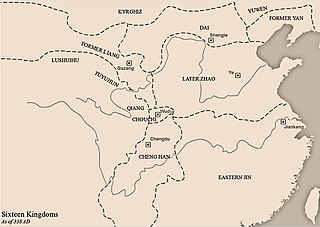
Hebei or, is a northern province of China. Hebei is China's sixth most populous province, with over 75 million people. Shijiazhuang is the capital city. The province is 96% Han Chinese, 3% Manchu, 0.8% Hui, and 0.3% Mongol. Three Mandarin dialects are spoken: Jilu Mandarin, Beijing Mandarin and Jin.

Hu Shih (Chinese: 胡適; pinyin: Hú Shì; Wade–Giles: Hu2 Shih4; 17 December 1891 – 24 February 1962), also known as Hu Suh in early references, was a Chinese diplomat, essayist, literary scholar, philosopher, and politician. Hu is widely recognized today as a key contributor to Chinese liberalism and language reform in his advocacy for the use of written vernacular Chinese. He was influential in the May Fourth Movement, one of the leaders of China's New Culture Movement, was a president of Peking University, and in 1939 was nominated for a Nobel Prize in literature. He had a wide range of interests such as literature, philosophy, history, textual criticism, and pedagogy. He was also an influential redology scholar and held the famous Jiaxu manuscript (甲戌本; Jiǎxū běn) for many years until his death.

The Shih Tzu is a toy dog breed originating from Tibet and having been bred from the Pekingese and the Lhasa Apso.

The Later Zhao was a dynasty of the Sixteen Kingdoms in northern China. It was founded by the Shi family of the Jie ethnicity. The Jie were most likely a Yeniseian people and spoke next to Chinese one of the Yeniseian languages. The Later Zhao was the second in territorial size to the Former Qin dynasty that once unified northern China under Fu Jiān.

Cangzhou is a prefecture-level city in eastern Hebei province, People's Republic of China. At the 2020 census, Cangzhou's built-up area made of Yunhe, Xinhua districts and Cang County largely being conurbated had a population of 1,421,843 inhabitants, while the prefecture-level administrative unit in total has a population of 7,300,783. It lies approximately 90 kilometres (56 mi) from the major port city of Tianjin, and 180 km (110 mi) from Beijing.
Ye or Yecheng was an ancient Chinese city located in what is now Linzhang County, Handan, Hebei province and neighbouring Anyang, Henan province.

Eomeropidae is a family of aberrant, flattened scorpionflies represented today by only a single living species, Notiothauma reedi, known from the Nothofagus forests in southern Chile, while all other recognized genera in the family are known only as fossils, with the earliest definitive fossil known from Liassic-aged strata, and the youngest from Paleogene-aged strata.

The Tiaojishan Formation is a geological formation in Hebei and Liaoning, People's Republic of China, dating to the middle-late Jurassic period. It is known for its exceptionally preserved fossils, including those of plants, insects and vertebrates. It is made up mainly of pyroclastic rock interspersed with basic volcanic and sedimentary rocks. Previously, the Tiaojishan Formation was grouped together with the underlying Haifanggou Formation as a single "Lanqi Formation." The Tiaojishan Formation forms a key part of the Yanliao Biota assemblage, alongside the Haifanggou Formation.
Ajaniopsis is a genus of flowering plants in the daisy family described as a genus in 1978.

Wanquan is a district of the city of Zhangjiakou, in the northwest of Hebei province, China, located just to the southwest of Zhangjiakou's urban core. It was the site of the Battle of the Badger's Mouth Pass, one of the major campaigns in the Mongol–Jin War
Notoseris is a genus of Asian flowering plants in the tribe Cichorieae within the family Asteraceae. The plants are native to Asia, primarily China.
Paraprenanthes is a genus of East Asian plants in the tribe Cichorieae within the family Asteraceae, most of the species found only in China.
The Dabeigou Formation is a palaeontological formation located in Hebei, China. It dates from the mid Valanginian to Hauterivian age of the Cretaceous period, approximately 135 to 130 Ma.
The Huajiying Formation is a geological formation in Hebei, People's Republic of China. Known for its fossils including feathered dinosaurs, the age of the formation is uncertain. It may represent an early portion of the Jehol Biota, dating to somewhere in the early Cretaceous or late Jurassic periods. It may correlate with the early Cretaceous Dadianzi Formation and parts of the Yixian Formation, with an age range between 140 and 122 Ma ago. It contains the Qiaotou Member, sometimes treated as a distinct formation.
Shenqiornis is a bird genus of the Enantiornithes. It was found in the Qiaotou Member of the Huajiying Formation of Hebei Province, China, and is therefore of uncertain age. The Qiaotou Member may correlate with the more well-known Early Cretaceous Yixian Formation, and so probably is dated to the Aptian, around 122 million years ago.

The Changchun–Shenzhen Expressway, commonly referred to as the Changshen Expressway, is an expressway that connects the cities of Changchun, Jilin, China, and Shenzhen, Guangdong. When complete, it will be 3,585 km (2,228 mi) in length.

Hebei Football Club is a professional Chinese football club that participates in the Chinese Super League division under licence from the Chinese Football Association (CFA). The team is based in Langfang, Hebei and their home stadium is the Langfang Stadium that has a seating capacity of 30,000. Their current owners are real estate developers China Fortune Land Development who took over the club on 27 January 2015.

Anordrin, also known as 2α,17α-diethynyl-A-nor-5α-androstane-2β,17β-diol dipropionate, is a synthetic, steroidal selective estrogen receptor modulator (SERM) which is used in China as an emergency contraceptive. It is the most commonly used emergency contraceptive in China. The drug is marketed in a combination formulation with mifepristone under the brand name Zi Yun. Anordrin has not been studied for use or marketed outside of China. It has been used in China since the 1970s.
Luopterus is an extinct genus of anurognathid pterosaur containing only the holotype species L. mutoudengensis that is known from the Middle Jurassic Tiaojishan Formation of Qinglong, northern Hebei Province, China. It was originally named as a species of Dendrorhynchoides in 2012 but it was moved to the genus Luopterus in 2020. Luopterus was originally thought to be from the Early Cretaceous, with a wingspan that is about 40 centimeters (16 in), making it one of the smallest known pterosaurs.










